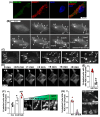Age-Related Increases in PDE11A4 Protein Expression Trigger Liquid-Liquid Phase Separation (LLPS) of the Enzyme That Can Be Reversed by PDE11A4 Small Molecule Inhibitors
- PMID: 40558524
- PMCID: PMC12190369
- DOI: 10.3390/cells14120897
Age-Related Increases in PDE11A4 Protein Expression Trigger Liquid-Liquid Phase Separation (LLPS) of the Enzyme That Can Be Reversed by PDE11A4 Small Molecule Inhibitors
Abstract
PDE11A is a little-studied phosphodiesterase sub-family that breaks down cAMP/cGMP, with the PDE11A4 isoform enriched in the memory-related hippocampal formation. Age-related increases in PDE11A expression occur in human and rodent hippocampus and cause age-related cognitive decline of social memories. Interestingly, age-related increases in PDE11A4 protein ectopically accumulate in spherical clusters that group together in the brain to form linear filamentous patterns termed "PDE11A4 ghost axons". The biophysical/physiochemical mechanisms underlying this age-related clustering are not known. Here, we determine if age-related clustering of PDE11A4 reflects liquid-liquid phase separation (LLPS; biomolecular condensation), and if PDE11A inhibitors can reverse this LLPS. We show human and mouse PDE11A4 exhibit several LLPS-promoting sequence features, including intrinsically disordered regions, non-covalent pi-pi interactions, and prion-like domains that were particularly enriched in the N-terminal regulatory region. Further, multiple bioinformatic tools predict PDE11A4 undergoes LLPS. Consistent with these predictions, aging-like PDE11A4 clusters in HT22 hippocampal neuronal cells were membraneless spherical droplets that progressively fuse over time in a concentration-dependent manner. Deletion of the N-terminal intrinsically disordered region prevented PDE11A4 LLPS despite equal protein expression between WT and mutant constructs. 1,6-hexanediol, along with tadalafil and BC11-38 that inhibit PDE11A4, reversed PDE11A4 LLPS in HT22 hippocampal neuronal cells. Interestingly, PDE11A4 inhibitors reverse PDE11A4 LLPS independently of increasing cAMP/cGMP levels via catalytic inhibition. Importantly, orally dosed tadalafil reduced PDE11A4 ghost axons in old mouse ventral hippocampus by 50%. Thus, PDE11A4 exhibits the four defining criteria of LLPS, and PDE11A inhibitors reverse this age-related phenotype both in vitro and in vivo.
Keywords: PDE11A; aging; biomolecular condensation; cognitive impairment; hippocampus; inclusion body; memory; phosphodiesterase; tadalafil.
Conflict of interest statement
There are no conflicts of interest.
Figures




Similar articles
-
Molecular mechanisms regulating PDE11A4 age-related liquid-liquid phase separation (LLPS) and its reversal by selective, potent and orally-available PDE11A4 small molecule inhibitors both in vitro and in vivo.bioRxiv [Preprint]. 2025 May 21:2025.05.20.654583. doi: 10.1101/2025.05.20.654583. bioRxiv. 2025. PMID: 40475610 Free PMC article. Preprint.
-
A Role for Phosphodiesterase 11A (PDE11A) in the Formation of Social Memories and the Stabilization of Mood.Adv Neurobiol. 2017;17:201-230. doi: 10.1007/978-3-319-58811-7_8. Adv Neurobiol. 2017. PMID: 28956334 Free PMC article. Review.
-
Conserved age-related increases in hippocampal PDE11A4 cause unexpected proteinopathies and cognitive decline of social associative memories.Aging Cell. 2022 Oct;21(10):e13687. doi: 10.1111/acel.13687. Epub 2022 Sep 8. Aging Cell. 2022. PMID: 36073342 Free PMC article.
-
WDR3 undergoes phase separation to mediate the therapeutic mechanism of Nilotinib against osteosarcoma.J Exp Clin Cancer Res. 2025 Jul 11;44(1):201. doi: 10.1186/s13046-025-03456-x. J Exp Clin Cancer Res. 2025. PMID: 40646517 Free PMC article.
-
Small Molecules as Regulators of Liquid-Liquid Phase Separation: Mechanisms and Strategies for New Drug Discovery.FASEB J. 2025 Jul 15;39(13):e70773. doi: 10.1096/fj.202501476R. FASEB J. 2025. PMID: 40616404 Review.
References
-
- Plassman B.L., Langa K.M., Fisher G.G., Heeringa S.G., Weir D.R., Ofstedal M.B., Burke J.R., Hurd M.D., Potter G.G., Rodgers W.L., et al. Prevalence of cognitive impairment without dementia in the United States. Ann. Intern. Med. 2008;148:427–434. doi: 10.7326/0003-4819-148-6-200803180-00005. - DOI - PMC - PubMed
MeSH terms
Substances
Grants and funding
LinkOut - more resources
Full Text Sources
Medical
Research Materials
Miscellaneous

